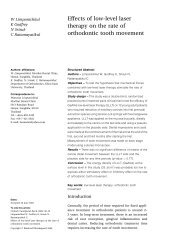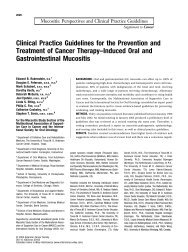Management of Mouth Opening in Patients with Temporomandibular ...
Management of Mouth Opening in Patients with Temporomandibular ...
Management of Mouth Opening in Patients with Temporomandibular ...
You also want an ePaper? Increase the reach of your titles
YUMPU automatically turns print PDFs into web optimized ePapers that Google loves.
46 Núñez et al.<br />
symptom. However, only a m<strong>in</strong>or percentage <strong>of</strong> the population<br />
presents problems severe enough to look for treatment for<br />
TMD. 2<br />
The prelim<strong>in</strong>ary management <strong>of</strong> TMD presumes that primary<br />
systemic or overt jo<strong>in</strong>t diseases have been identified and<br />
addressed. 3 A vast array <strong>of</strong> therapeutic modalities has been <strong>of</strong>fered<br />
for TMD patients. 2 Researchers generally agree that caution<br />
is recommended <strong>with</strong> regard to the use <strong>of</strong> <strong>in</strong>vasive and<br />
irreversible treatments, particularly <strong>in</strong> the <strong>in</strong>itial management<br />
<strong>of</strong> TMD. A number <strong>of</strong> non<strong>in</strong>vasive and reversible therapies appear<br />
to help most patients. 3,4<br />
The <strong>in</strong>itial management <strong>of</strong> TMD <strong>in</strong>cludes supportive patient<br />
education, pharmacologic pa<strong>in</strong> control, and physical therapy—<br />
i.e., moist heat, ultrasound, and transcutaneous electrical<br />
neural stimulation (TENS). 2<br />
TENS is used to relax hyperactive muscles; it acts like a neuromuscular<br />
stimulator. TENS equipment produces a lowamplitude,<br />
low-frequency alternat<strong>in</strong>g stimulus that causes<br />
muscles to contract and relax. Applied bilaterally between the<br />
temporomandibular jo<strong>in</strong>t (TMJ) and the coronoid process, the<br />
stimulus reaches the deep mandibular division <strong>of</strong> the trigem<strong>in</strong>al<br />
nerve, as well as the superficial facial nerve. 5 This therapy is applied<br />
to reduce the muscular activity <strong>of</strong> masticatory muscles. 6<br />
Low-level laser therapy (LLLT) seems to be <strong>in</strong> accordance<br />
<strong>with</strong> TMD’s treatment philosophy, because it represents a non<strong>in</strong>vasive,<br />
reversible therapy <strong>with</strong>out any known side effects.<br />
LILT makes use <strong>of</strong> the electromagnetic radiation <strong>of</strong> a s<strong>in</strong>gle<br />
wavelength, usually <strong>in</strong> the red or <strong>in</strong>frared regions. LLLT provides<br />
treatment for several pathologies, <strong>in</strong>clud<strong>in</strong>g impaired<br />
wound heal<strong>in</strong>g, pa<strong>in</strong> conditions, and <strong>in</strong>flammatory situations. 7,8<br />
Several reports have documented the positive effects <strong>of</strong><br />
LLLT <strong>in</strong> TMD. 9,10 Kulekcioglu et al. 9 showed that, after 15 sessions<br />
<strong>of</strong> LLLT, TMD <strong>of</strong> both myogenic and arthrogenic causes<br />
responded to therapy <strong>with</strong> a significant reduction <strong>in</strong> pa<strong>in</strong>, improvement<br />
<strong>in</strong> mouth open<strong>in</strong>g and lateral motion, and a dim<strong>in</strong>ished<br />
number <strong>of</strong> trigger po<strong>in</strong>ts. However, the cl<strong>in</strong>ical efficacy<br />
<strong>of</strong> LLLT has been questioned. 11 Given the large range <strong>of</strong> treatment<br />
parameters <strong>in</strong>volved <strong>in</strong> this therapy (i.e., wavelength, fluence,<br />
<strong>in</strong>tensity, exposure time, total duration <strong>of</strong> treatment), it is<br />
not difficult to understand that results differ from one study to<br />
the next. 12<br />
LLLT, <strong>with</strong> the appropriate parameters, may act as an analgesic<br />
and anti-<strong>in</strong>flammatory mediator to promote muscle relaxation.<br />
Accord<strong>in</strong>g to some reports, LLLT may promote<br />
analgesic effects via several mechanisms (e.g., <strong>in</strong>creases liberation<br />
<strong>of</strong> endogenous opiates; decreases permeability <strong>of</strong> the<br />
nerve cell membrane; decreases release <strong>of</strong> algesic agents <strong>in</strong><br />
pathological sites; <strong>in</strong>creases ATP production; and decreases tissue<br />
asphyxia 13,14 ).<br />
Range <strong>of</strong> mouth open<strong>in</strong>g is impaired <strong>in</strong> patients <strong>with</strong><br />
TMD. 15 Limitation <strong>in</strong> mouth open<strong>in</strong>g makes access to the oral<br />
cavity difficult, lead<strong>in</strong>g to complications <strong>in</strong> the rehabilitative<br />
treatment <strong>of</strong>ten necessary <strong>in</strong> patients <strong>with</strong> TMD. Appropriate<br />
access to the oral cavity is necessary to replace miss<strong>in</strong>g teeth,<br />
to promote occlusal equilibration, or to perform dental impressions<br />
to build up removable and functional oral appliances. 2<br />
These treatments can represent a stressful condition to patients<br />
due to the pa<strong>in</strong> provoked by the open<strong>in</strong>g movement. 16,17<br />
Therefore, the aim <strong>of</strong> this work is to evaluate the range <strong>of</strong><br />
motion <strong>of</strong> mouth open<strong>in</strong>g <strong>in</strong> patients <strong>with</strong> diagnoses <strong>of</strong> TMD<br />
before and after treatment <strong>with</strong> LLLT or TENS to observe the<br />
cl<strong>in</strong>ical effectiveness <strong>of</strong> each method.<br />
METHODS<br />
The present study <strong>in</strong>volved 10 patients from a private dental<br />
<strong>of</strong>fice <strong>with</strong> diagnoses <strong>of</strong> TMD <strong>of</strong> multiple causes. Informed<br />
consent for participation <strong>in</strong> this study was obta<strong>in</strong>ed <strong>in</strong> all cases.<br />
Follow<strong>in</strong>g a prelim<strong>in</strong>ary evaluation to exclude patients <strong>with</strong><br />
systemic disease that could be associated <strong>with</strong> TMD and overt<br />
jo<strong>in</strong>t diseases, the <strong>in</strong>clusion criteria comprised two conditions:<br />
limitation <strong>of</strong> mouth open<strong>in</strong>g due to pa<strong>in</strong>, and not hav<strong>in</strong>g medical<br />
or pharmacological treatment for TMD <strong>in</strong> the past 6 months.<br />
The patients were 80% female and 20% male. The mean age<br />
was 34.4 years (range, 18–56 years). <strong>Patients</strong> presented multiple<br />
causes <strong>of</strong> TMD, <strong>with</strong> compla<strong>in</strong>ts <strong>of</strong> pa<strong>in</strong> <strong>in</strong> the TMJ area.<br />
Dur<strong>in</strong>g the study, patients were <strong>in</strong>structed to not take systemic<br />
medication for TMD.<br />
Prior to therapies, the patient was set <strong>in</strong> a chair <strong>with</strong> a standard<br />
position <strong>of</strong> 45 degrees between the upper and lower<br />
members. The head was supported by a head rest. <strong>Patients</strong><br />
were <strong>in</strong>structed to open their mouth until it reached maximum<br />
capability <strong>with</strong>out excessive discomfort. With a millimeter<br />
ruler, the total mouth open<strong>in</strong>g was recorded, <strong>with</strong> the measure<br />
be<strong>in</strong>g performed from the <strong>in</strong>cisal <strong>of</strong> the upper <strong>in</strong>cisors to the<br />
<strong>in</strong>cisal <strong>of</strong> the lower <strong>in</strong>cisors. Initial values were recorded; all<br />
patients received both methods randomly alternated, <strong>in</strong> one<br />
treatment session per week, <strong>in</strong> 2 consecutive weeks. Dur<strong>in</strong>g<br />
the first week, five patients had laser irradiation and five patients<br />
had TENS application. After 7 days, the mouth open<strong>in</strong>g<br />
was measured as previously described. Thereafter, patients<br />
that had LLLT on the previous week got TENS therapy and<br />
vice versa.<br />
LLLT was performed <strong>with</strong> a cont<strong>in</strong>uous-wave diode laser<br />
(GaAlAs; Kroman, São Paulo, Brazil), emission wavelength<br />
<strong>of</strong> 670 nm, output power <strong>of</strong> 50 mW for 60 sec, 3 J per site.<br />
Four sites were chosen to receive the irradiation: the area<br />
over the masseter muscle, over the temporal muscle, over the<br />
mandibular condyle, and <strong>in</strong>tra-auricular. 18 The treatment was<br />
performed bilaterally <strong>with</strong> total time duration <strong>of</strong> 8 m<strong>in</strong>. The<br />
<strong>in</strong>tensity was 0.25 W/cm 2 . The laser output power was measured<br />
prior to irradiation us<strong>in</strong>g a calibrated detector<br />
(LaserCheck ® , Coherent).<br />
TENS therapy was executed <strong>with</strong> a two-electrode mach<strong>in</strong>e<br />
(model hv250r; Hitachi Home Electronics Inc., Japan). The<br />
power was 20 W, <strong>with</strong> a maximum frequency <strong>of</strong> 60 Hz. The patients<br />
were <strong>in</strong>structed to adjust the <strong>in</strong>tensity <strong>of</strong> the equipment<br />
accord<strong>in</strong>g to their sensitivity so that the treatment would not be<br />
uncomfortable; the equipment has five different <strong>in</strong>tensities.<br />
The total duration <strong>of</strong> the treatment was 30 m<strong>in</strong>. Each electrode<br />
was placed <strong>in</strong> one side, so the treatment was performed bilaterally.<br />
The position <strong>of</strong> the electrode was between the TMJ and<br />
the coronoid process, to allow the arrival <strong>of</strong> the stimulus to the<br />
trigem<strong>in</strong>al nerve, as well as to the facial nerve.<br />
The total aperture measurement was recorded before and<br />
immediately after therapies. The results were compared for<br />
each <strong>in</strong>dividual treatment (before and after treatment values) as<br />
well as between treatments (mean <strong>of</strong> the after treatment<br />
improvement).











